Caryodendron is a plant genus of the family Euphorbiaceae first described as a genus in 1860. The genus includes C. orinocense, known as the Inchi tree or Tacay nut. It is native to Central America and South America. They are dioecious trees.
- Caryodendron amazonicumDucke - Amazonas in Brazil
- Caryodendron angustifoliumStandl. - Costa Rica, Panama, Colombia
- Caryodendron janeirenseMüll.Arg. - Rio de Janeiro
- Caryodendron orinocenseH.Karst - Colombia, Venezuela, Ecuador

The Cordillera de Talamanca is a mountain range that lies in the southeast half of Costa Rica and the far west of Panama. Much of the range and the area around it is included in La Amistad International Park, which also is shared between the two countries.
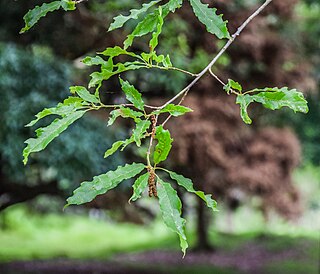
Quercus lancifolia is a species of oak found in Central America and Mexico.
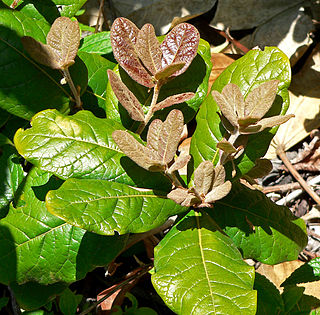
Quercus costaricensis is a species of oak native to Central America. It is often found with Quercus copeyensis in the upper montane forests, to 3,100 metres elevation. The leaves are tough and leathery with a short petiole and toothed margin. Wind is the primary pollinator. Squirrels are their main seed predator but also their main disperser as they commonly lose their buried seeds.

The Talamancan montane forests ecoregion, in the tropical moist broadleaf forest biome, are in montane Costa Rica and western Panama in Central America.
Cornelius Herman ("Neil") Muller, born Müller, was an American botanist and ecologist who pioneered the study of allelopathy and oak classification.

Alnus acuminata is a species of deciduous tree in the Betulaceae family. It is found in montane forests from central Mexico to Argentina.
The Central America bioregion is a biogeographic region comprising southern Mexico and Central America.
Alfaroa manningii, or gavilán colorado, is a valued lumber tree of the Walnut family endemic to the premontane Costa Rican rain forest. The specific epithet honors the American botanist Wayne Eyer Manning (1899–2004).
Systeloglossum is a genus of flowering plants from the orchid family, Orchidaceae. It contains 5 known species, all native to southeastern Central America and northwestern South America.
- Systeloglossum acuminatumAmes & C.Schweinf. - Costa Rica, Panama
- Systeloglossum bennettii(Garay) Dressler & N.H.Williams - Peru
- Systeloglossum costaricenseSchltr. - Peru
- Systeloglossum ecuadorense(Garay) Dressler & N.H.Williams - Ecuador
- Systeloglossum panamenseDressler & N.H.Williams - Panama

Quercus polymorpha, the Mexican white oak, Monterrey oak or netleaf white oak, is a North American species of oak. It is widespread in Mexico, Guatemala, and Honduras, and known from a single population in the United States but widely planted as an ornamental.

Quercus humboldtii, commonly known as the Andean oak, Colombian oak or roble, is a species of oak found only in Colombia and Panamá. It is named for Alexander von Humboldt.
Quercus oleoides, with Spanish common names encina or encino, is a Mesoamerican species of oak in the southern live oaks section of the genus Quercus. It grows in dry forests and pastureland of eastern and southern Mexico and much of Central America, from Guanacaste Province in Costa Rica north as far as the State of Tamaulipas in northeastern Mexico.
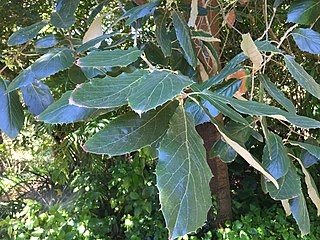
Quercus calophylla is a Mesoamerican species of oak tree. It is native to mountain forests of central and southern Mexico, Guatemala, and El Salvador. It has incorrectly been known as Quercus candicans.

Quercus insignis is a Mesoamerican species of oak in the white oak section, within the beech family. It is native to southern Mexico and Central America, from Veracruz to Panamá.
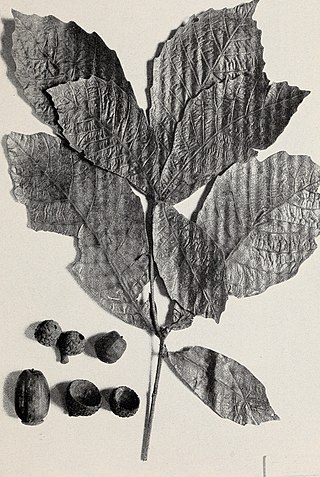
Quercus oocarpa is a Mesoamerican species of oak.

Quercus salicifolia is a species of oak. It is native to central and southern Mexico and Central America, from Jalisco to Panama.
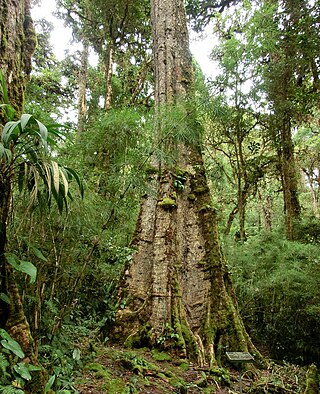
Quercus sapotifolia is a species of oak. It is native to southern and western Mexico as well as Central America. It is threatened by habitat loss.

Sciodaphyllum pittieri is a species of flowering plant in genus Sciodaphyllum. It is native to the mountain forests of Costa Rica and western Panama.













